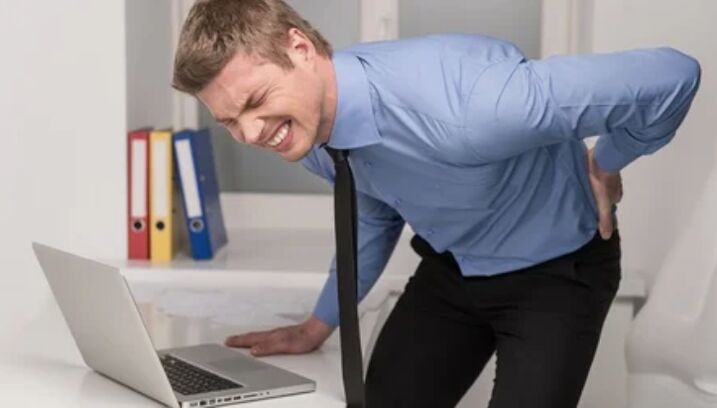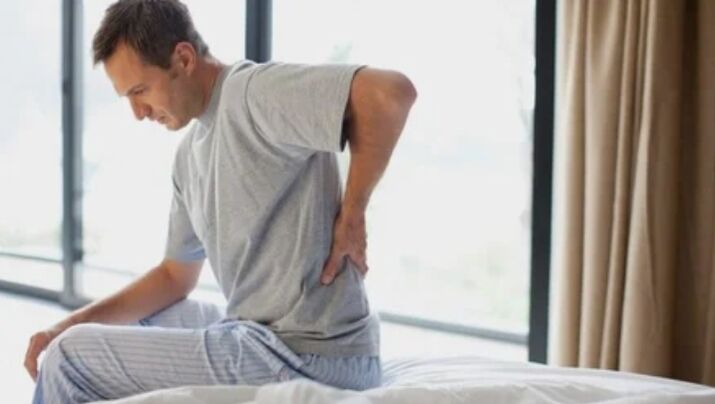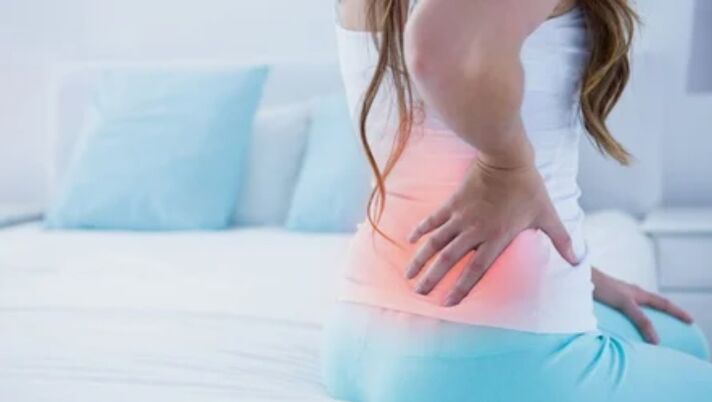With the advent of discomfort in the spine, almost every person faces.Using pain relievers, most of the population does not even ask the question of why the back hurts, attributing negative manifestations on colds, drafts or the consequences of stretching.Meanwhile, pain syndrome (BS) can be an alarming signal for the appearance of serious pathologies.

In different parts
Back pain is different.
Among them are distinguished:
- Struggle.Differ in frequency.
- Growth.In the process of pathological conditions, an increase in the degree of intensity of uncomfortable manifestations occurs.
- Dagger.Are a consequence of emergency conditions.
- In the form of fires.They are recorded in the event of an altered functionality of the spine.
- Permanent or monotonous.
In addition, back pain can be of two types:
- Projected.It spreads along the nerve fibers.It can radiate in distal parts of the body.
- Reflected.Appears during malfunctions in the work of internal organs.
On the right side
There are a number of circumstances that explain why the back hurts right.They are:
- The result of hypodynamia, because of which the abdominal muscles lose their elasticity and their elasticity, while the whole load is placed on the spine;
- injuries and bruises of soft tissue;
- Perform physical work in a unnatural position (with an uneven charge).
In addition to natural factors, the cause of uncomfortable sensations at the rear can be diseases of the internal organs and the musculoskeletal system.
This symptom can be part of the clinical picture of the following diseases:
- Diseases of the respiratory system.With the inflammation of the lungs (pneumonia on the right), in addition to back pain, the patient complains about the appearance of a dry cough, a general weakness, an increase in the body temperature indicator.
- The spicy BS on the right is observed with pleurisy.It is accompanied by the discharge of purulent expectations and the difficulty of breathing.
- Pathology of liver and gallbladder.BS is distinguished by the duration of the current.To stop it, pain relievers or antispasmodic drugs are used.The clinical picture is supplemented by signs of intoxication (nausea, vomiting, violation of the defecation law).
- Gastrointestinal diseases.With pancreatitis or gastritis, pain syndrome is generally located on the left side, but often radiates to the right.
- Urinary diseasesThey manifest themselves in prolonged or stupid pain.It occurs in the context of frequent urination, with the advent of red blood cells (blood) in urine.A distinctive feature is that a sick person cannot find a practical body position to reduce back pain.
- Appendicitis.In addition to the unpleasant sensations in the abdomen, the patient notes that the back hurts the right side.Additional symptoms are the appearance of nausea and vomiting reflexes, an increase in the body temperature indicator, a general failure.
- Gynecological pathologies.The manifestations of discomfort on the right are recorded in the event of an extra-uterine pregnancy, inflammation of the appendages or due to the growth of the cystic ovarian seals.
- Osteochondrosis.The pain can be located on the right and on the left.It is accompanied by stiffness in movements and increases with physical work (especially if a person performs it for the first time).In advanced forms, irradiation in the fingers with their numbness is observed.
On the left side
The location of back pain can be the main or additional symptom in the clinical image of many diseases.

This can happen in the following cases:
- Vertebral column disease.Most often, the patient complains that the back hurts due to osteochondrosis, intercostal neuralgia or when he has pinched the nerve.The clinical image is supplemented by a stiffness in the movements, a radiation in the upper limb, a loss of sensitivity in the fingers.
- Stomach and intestines diseases.Symptoms of pain manifestations are supplemented by the presence of nausea, vomiting, stool disorders and increased gas formation.These signs appear with the development of pancreatitis, intestinal colic, cholecystitis.
- Cardiological diseases.Acute pain syndrome from behind under the ribs in combination with shortness of breath and a burning sensation behind the sternum is a characteristic sign of myocardial infarction.
- In bronchi and lungs, BS can be observed with the development of pneumothorax, pleurisy, bronchitis or pneumonia.It can intensify during inhalation and reduce expiration.
In the lower back area
The lumbar region starts from where the coasts end and end with a coccyge.Most often, patients, the search for medical aid for back pain complaints, involve the lower back.
The causes of lumbar pain are the following conditions:
- 90% of all lumbar pain cases are explained by a violation of the functionality of the spine (osteochondrosis, hernias between the vertebrae, scoliosis, radiculitis).These conditions are characterized by symptoms in the form of sudden fire.
- In 6%, pain in the lower back is the result of a violation of the urinary organs.This characteristic manifests itself for pyelonephritis, cystitis, glomerulonephritis or in the formation of calculations (stones) in the kidneys.
- 4% are diseases of other internal organs (stomach, intestines).
In the blades area
A person may feel pain in the field of shoulder blades in different location places:
- Pain syndrome is located under the shoulder blades.This nature of the BS is noted in the presence of ulcers and erosion in the stomach.At the same time, the main epicenter of negative sensations is concentrated in the epigastric zone, and the irradiation gives it to the shoulder.
- Compression of the chest, painful and stupid pain often cause osteochondrosis or myositis.
- When the back hurts between the shoulder blades, then with a high degree of probability, it can be assumed as to the location of intercostal neuralgia (if the BS occurs in the form of a chimney).In the case of pneumonia development, painful sensations are improved by cough and at the top of the sigh.
- The BS in the shoulder blades are most often manifested as a post-traumatic consequence.Symptoms of negative sensations are improved when the upper limbs move.

Along the spine
The cause of back pain along the spine may be the following conditions:
- Lumbalgia.It manifests itself acutely after raising weights.
- Perche, scoliosis or cyphosis cause uncomfortable sensations that manifest themselves by pulling or hurting the BS.
- An hernial projection between the vertebrae leads to the compression of the nerve roots, which is why a burning sensation appears along the spine.In this case, there is a loss of sensitivity in the back.
- Cervical and thoracic osteochondosis leads to changes in the thorny processes of the vertebrae, which becomes a consequence of the constant wound of their nerve endings.This causes back pain and stiffness in movements.
- Injuries cause acute and clear pain syndrome.In case of damage to the spinal cord, sensitivity to the lower limbs occurs.
- Arthritis is characterized by a gradual increase in discomfort, with the appearance of the crisis and the click in the vertebrae.
- Endometriosis and adnexite cause a feeling of discomfort in the spine due to the anatomical arrangement of female reproductive organs (in the bottom of the abdomen).
Under the lower back
The Lombo-Sacré department most often undergoes the load due to a poor lifting of gravity, a prolonged step or staying in a sitting position.But these situations partly explain why the back hurts under the lower back.
The discomfort occurs at:
- Pathological changes in the spine (osteoarthritis, osteochondrosis, hernia protrusion between the vertebrae);
- After a sacrum or coccyx injury;
- In the event of a violation of the posture (scoliosis or lordosis).
Pain in the sacred department appears in the diseases of the genitarian sphere, constipation, cholecystitis or gastritis.In women, this symptom can indicate pregnancy or menopause.Sometimes he preiets the start of the menstrual cycle.
Pain in the back after sleep
Sometimes a person notes strong fatigue and a break after a night of rest.

Most often, the following factors contribute to it:
- Inappropriate organization of the berth (mattress too hard or soft);
- increased physical activity or a large amount of work during the day;
- Destructive changes with an alteration of the functionalities of the vertebrae and the discs between them;
- age -related changes in the cartilage tissue of intervertebral discs;
- consequences of injuries;
- Inflammation in the internal organs of the abdominal cavity.
Pain in muscles
The pathological processes in the vertebrae and the intervertebral discs modify the structure of the bone and cartilage.For this reason, there is a overvoltage of muscles and fascia tendon.This leads to the fact that the body reacts with the occurrence of BS.
In some cases, it should be noted that the back hurts after a long stay on the project or during hypothermia.These two factors contribute to the manifestation of myositis, in which pain is located in the surface muscles.A distinctive characteristic of it is an increase in discomfort on palpation or when the patient tries to make turns or an inclination with the body.Sometimes its symptoms appear after sprains and bruises.
Painful syndrome in muscle groups often occurs due to intense training in athletes.In this case, overloaded muscle fibers lose their elasticity, the seals appear in them, which are detected on palpation.
Causes of diseases
The pain in the back is diagnosed with various diseases.
These include:
- pathological process in the spine (hernia, spondylated that arthralgia, radiculitis);
- Myocardial infarction, aorta aneurysm;
- stomach diseases and intestines (pancreatitis, colitis);
- The training of calculations in the kidneys, cholecystitis, colic of the liver.
At the same time, all diseases have a different etiology, which is taken into account when choosing a treatment tactic.
Degenerative pathologies
Degenerative changes occur in cartilage and bone tissue.The violation of the morphological structure causes dystrophy, which is why osteochondrosis, spondylosis or spondyl osteoarthritis occurs.
Among the factors caused from destructive changes, they distinguish:
- Metabolism violation causing insufficient consumption of nutrients to intervertebral discs;
- Limited contribution of beneficial trace elements in the body;
- Large charges and injuries;
- Dysfunctions of the endocrine system;
- Bad habits, for example, smoking and excessive dependence on alcoholic drinks;
- Hypodynamia and sedentary lifestyle.
Inflammatory diseases
Diseases leading to inflammation in the spine can occur both independently and be the result of complications of pathologies.They are recorded in rare cases, but constitute a serious threat to the patient's health.

Inflammation can be located in different parts of the vertebra:
- In the front section, spondylated that dycite or spondyliscitis is most often diagnosed;
- The location in the rear section causes the development of osteomyelitis, spondylitis or paravertebral abscesses;
- If the vertebral canal is infected, inflammation manifests itself by the development of an abscess or epiduritis.
In addition, tissues in the spine can be affected due to tuberculosis, brucellosis, trichinellosis (a variety of helminthiasis).
This type of pathology is characterized by net attacks in muscle groups, which are difficult to eliminate pain relievers.The clinical picture can be supplemented by related symptoms, for example, with a spasmodic increase in body temperature and the loss of sensitivity in certain areas of the spine.
Mifascial syndrome
Myofascial syndrome has a chronic course with the formation of seals in muscle tissue in the form of pain points (trigger).This not only causes severe discomfort, but also leads to a decrease in motor activity, following which the patient is quickly tired even with a minor physical activity.
The probability of developing myofascial syndrome increases several times in the following situations:
- osteochondrosis, spondylrosis, wounds and bruises;
- in the case of the diagnosis of scoliosis or with flat feet;
- If the work is linked to the repetition of stereotypical movements;
- In the event of a violation of the psychomotional state (if this happens with an increase in muscle stress).
An important importance in clinical practice is given to the state of trigger points.They are active or latent.
Given this, they are classified as follows:
- Acute shape.The trigger points are in an active state and cause a feeling of discomfort when you try to make a movement.
- Subali.Negative manifestations disappear at rest.
- Chronic.The latent state only causes insignificant discomfort in the corresponding area.
In addition, in order to make the right choice of therapy, a classification is adopted in neurology according to the etiological principle:
- Primary trigger points are formed due to muscle damage;
- Secondary is recorded in violation of the functionality of joints and somatic organs.
Physiological causes
A different group of physiological causes to cause pain in the muscle corset is called domestic.They do not need treatment and pass alone, after a small rest.
These include:
- do hard physical work for a long time;
- Weaken or fatigue of the body;
- Wrongly incorrectly selected for night rest or commit monotonous actions during work;
- Poor organization of a place for night sleep;
- A poorly selected mattress or pillow.
To establish the cause of back pain, you need to consult a doctor, as this may require a number of diagnostic measures.This will determine the tactics of the processing process, which will not allow only the transition of the disease to a neglected form.






















